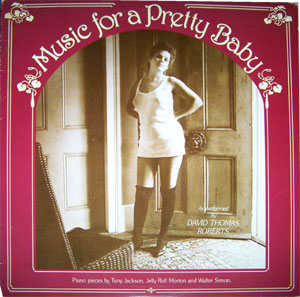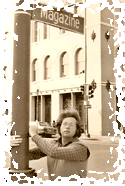Music for a Pretty Baby

(Mardi Gras Records, New Orleans, LA, 1978 - LP. Re-released in 1993 as Best Of New Orleans Ragtime Piano - CD)
Status: Available at JazzByMail
Track Listing & Liner Notes
- Pretty Baby (Kahn-T. Jackson-van Alstyne). Pretty Baby is one of those Jackson tunes of long delayed publication. Appearing in 1916, it was actually composed during his Storyville period. Although it was been recorded many times in jazz and popular arrangements, the beautiful instrumental version is seldom heard. The present instrumental version closely follows the piano part of the original arrangement for voice and piano.
- Kansas City Stomps (Ferdinand Morton). The Pearls, Kansas City Stomps, Fat Frances, and Stratford Hunch are the most ragtime-influenced Morton pieces on this album. ... Kansas City Stomps is notable for the sensuous dissonances in its trio. It was named for a bar in the Tia Juana.
- Mamanita (Ferdinand Morton). Mamanita exemplifies Morton's most thoroughly Latin-American vein. The introspective performance of this work on the Library of Congress tapes includes some of his most remarkable improvising.
- Fat Frances (Ferdinand Morton). The Pearls, Kansas City Stomps, Fat Frances, and Stratford Hunch are the most ragtime-influenced Morton pieces on this album. ... The seldom-performed Fat Frances is a lyrical stomp which owes a good deal of its seductiveness to the subtle presence of "Spanish tinge."
- Honky Tonk Music (Ferdinand Morton). Honky Tonk Music sounds like an improvisatory recollection of one way in which "Spanish tinge" material and the most primitive blues may have been combined around 1900.
- Stratford Hunch (Ferdinand Morton). The Pearls, Kansas City Stomps, Fat Frances, and Stratford Hunch are the most ragtime-influenced Morton pieces on this album. ... Perhaps it is Stratford Hunch (also known as Chicago Breakdown) that ultimately personifies the Morton stomp. It is an intoxicating and romantic piece which, like its brother Shreveport Stomp, culminates in a stomping, crying trio of almost intolerable emotive energy. When played, as Jelly said, with "plenty rhythm, plenty swing," this trio swings with a bittersweet poignance that stands uneclipsed in the gamut of American piano music.
- The Pearls (Ferdinand Morton). The Pearls is the classic jazz piano piece par excellence. It was this elegant stomp that Morton himself considered to be the most difficult of his piano solos.
- Tom Cat Blues (Ferdinand Morton). Tom Cat Blues is typical of Morton's blues oeuvre, bearing a close resemblance to Midnight Mama and the famous Winin' Boy.
- Mr. Jelly Lord (Ferdinand Morton). Mr. Jelly Lord exists both as a song and as an instrumental piece. There are several band versions, but only one solo arrangement, a piano roll made in 1924 for the Vocalstyle Company, is known to exist. The exquisite trio was only included in the piano roll version. This melody well demonstrates the highly emotive, yearning character of much of his best material.
- New Orleans Joys (Ferdinand Morton). The tango-blues New Orleans Joys (also called New Orleans Blues) may well be the earliest Morton composition included here. On the Library of Congress recordings, he states that it was written in 1902 and that it is representative (presumably in its employment of the tango bass) of much early blues in New Orleans.
- The Naked Dance (T. Jackson-Ferdinand Morton). The Naked Dance has been preserved thanks to Jelly Roll Morton's recording and J. Lawrence Cook's transcription of it. In Alan Lomax's biography of Morton, Mr. Jelly Roll, Jelly explains that The Naked Dance was "one of Tony Jackson's first speed tunes like he used to play years ago... Tony used to play these things in the sporting houses for what they called the Naked Dances. Of course, they were naked dances all right, for they absolutely were stripped." Though very much unlike better known varieties of ragtime, such as Missouri classic ragtime or the Eastern "shout school," The Naked Dance is a rag and, when treated sensitively, a lovely composition.
- Sponge (W.C. Simon). The little-known Walter C. Simon's Sponge is one of the most original of all ragtime compositions. Published at 733 Canal St. (at the address of the Grunewald Co. where Simon worked as a salesman) in 1911, its title is derived from a synonym for "pimp." Although less sophisticated by European standards than a piece by Joplin, Scott, or Lamb, Sponge is as imaginative as Joplin's Euphonic Sounds. Sponge abounds with broken classical rules; parallel fifths, parallel octaves and unconventional doublings and voice leadings occur. But the more familiar one becomes with the rag, the more tenable every eccentricity seems. The raw fifths of the second strain seem at once forceful and ironic. And when this theme is stated the second and third time (the latter instance ending the piece), the sixteenth bar is missing thereby creating what must certainly be the only fifteen bars melody in ragtime. For these reasons and many intangible others this darkly unique piece comprises one of the most compelling adventures in ragtime.

